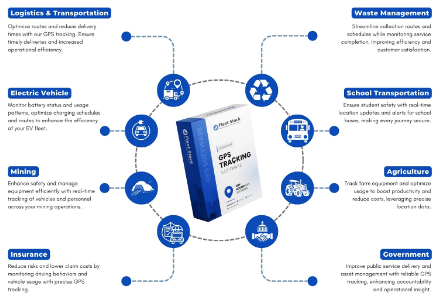Starting your own GPS tracking business can be a lucrative and rewarding venture. With the increasing demand for real-time tracking solutions in various industries, from transportation and logistics to personal safety and asset management, there’s never been a better time to enter this market.
This comprehensive guide will walk you through the steps necessary to start your own GPS tracking business.
Why Start a GPS Tracking Business?
GPS tracking systems offer numerous benefits that make them essential tools for businesses and individuals alike:
- Real-time Location Monitoring: Track vehicles, assets, and individuals in real-time.
- Improved Security: Enhance the security of vehicles and assets by monitoring their movements.
- Operational Efficiency: Optimize routes and reduce fuel consumption for fleet management.
- Data Analytics: Gain insights into usage patterns and performance.
- Compliance: Ensure compliance with industry regulations and safety standards.
Step by Step Process To Start Your Own GPS Tracking Business
Step 1: Research and Planning
Market Research
Conduct thorough market research to understand the demand for GPS tracking solutions in your target area. Identify potential customers, such as:
- Transportation and Logistics Companies: Need to track fleets of vehicles.
- Delivery Services: Require real-time tracking for efficient deliveries.
- Personal Users: Want to track family members or personal vehicles.
- Asset Management: Businesses needing to track valuable equipment or goods.
Business Plan
Create a detailed business plan outlining your business model, target market, pricing strategy, and financial projections. Your business plan should include:
- Executive Summary: Overview of your business.
- Market Analysis: Insights from your market research.
- Business Model: How you plan to generate revenue.
- Marketing Strategy: How you will attract and retain customers.
- Financial Plan: Budget, funding needs, and profit projections.
Step 2: Legal and Administrative Setup
Register Your Business
Choose a suitable business name and register your company with the relevant authorities in your area. Decide on the business structure (e.g., sole proprietorship, partnership, LLC, corporation) and obtain any necessary licenses and permits.
Legal Compliance
Ensure your business complies with local laws and regulations related to GPS tracking and data privacy. This may include:
- Data Protection Regulations: Compliance with GDPR, CCPA, or other relevant data protection laws.
- Consumer Protection Laws: Ensuring transparent communication and fair business practices.
Step 3: Develop Your GPS Tracking Solution
Setting Up Your Own GPS Tracking Software
As technology evolves, setting up your own GPS tracking server has become significantly easier, requiring no advanced technical skills.
With Fleet Stack, you can quickly and effortlessly establish your GPS tracking system. Here is a complete overview: simply visit Fleet Stack, download the GPS server setup, and install it on any server to start tracking your vehicles.
Fleet Stack stands out as one of the most powerful and modern GPS tracking solutions available. Its sleek, user-friendly interface and one-touch installation process make it incredibly accessible, even for newcomers. Whether you’re looking to enhance your existing logistics operations or start your own vehicle tracking business, Fleet Stack provides all the tools you need to succeed. Download, install, and start tracking with ease—Fleet Stack makes vehicle tracking simple and efficient.
Hardware Selection
Choose compatible GPS tracking devices that work seamlessly with your chosen software. Consider factors such as:
- Compatibility: Ensure devices are compatible with your software.
- Accuracy: High-precision devices for accurate tracking.
- Durability: Robust devices suitable for various environments.
- Battery Life: Long-lasting battery to reduce maintenance.
Integration and Testing
Integrate the GPS tracking devices with your software and conduct thorough testing to ensure everything works correctly. Address any technical issues and optimize the system for performance and reliability.
Step 4: Set Up Your Operations
Infrastructure
Set up the necessary infrastructure, including servers, databases, and network connectivity. Ensure your system is scalable to accommodate business growth.
Customer Support
Establish a customer support team to assist clients with setup, troubleshooting, and ongoing support. Provide multiple channels for support, such as phone, email, and live chat.
Training
Train your staff on using the GPS tracking system and handling customer inquiries. Ensure they are knowledgeable about the features and benefits of your solution.
Step 5: Marketing and Sales
Branding
Develop a strong brand identity, including a logo, tagline, and consistent branding across all marketing materials. Create a professional website that highlights your services and provides easy access to information.
Digital Marketing
Leverage digital marketing strategies to reach your target audience:
- Search Engine Optimization (SEO): Optimize your website for search engines to attract organic traffic.
- Content Marketing: Create valuable content, such as blog posts, case studies, and whitepapers, to educate potential customers.
- Social Media Marketing: Use social media platforms to engage with your audience and promote your services.
- Email Marketing: Build an email list and send regular newsletters and promotional offers.
Sales Strategy
Develop a sales strategy to convert leads into customers. This may include:
- Direct Sales: Hire a sales team to reach out to potential clients.
- Partnerships: Partner with complementary businesses to expand your reach.
- Free Trials: Offer free trials or demonstrations to showcase the benefits of your GPS tracking solution.
Step 6: Monitor and Improve
Customer Feedback
Collect feedback from your customers to identify areas for improvement. Use surveys, reviews, and direct communication to gather insights.
Continuous Improvement
Regularly update your GPS tracking software and devices to incorporate new features and improvements. Stay informed about industry trends and advancements to keep your business competitive.
Performance Metrics
Track key performance metrics, such as customer acquisition cost, customer retention rate, and revenue growth, to evaluate your business’s success and make informed decisions.
Conclusion
Starting your own GPS tracking business involves careful planning, technical expertise, and a focus on customer satisfaction. By following this comprehensive guide, you can establish a successful GPS tracking business that meets the needs of various industries and provides valuable services to your clients.
With Fleet Stack‘s robust and user-friendly solution, you’ll be well-equipped to deliver top-notch GPS tracking services and grow your business. Start your journey in the GPS tracking industry today and unlock the potential for growth and success.




































